ECF1110 - Economics: Supply, Demand, and the Electric Vehicle Market
VerifiedAdded on 2023/06/07
|9
|1978
|103
Essay
AI Summary
This essay examines the economics of electric vehicles, focusing on supply and demand dynamics, cross-price elasticity, and the impact of government policies. It analyzes the relationship between electric vehicles, electric vehicle charging stations, and traditional fuel vehicles, considering factors like price changes and government subsidies. The essay also discusses how government incentives can promote the adoption of electric vehicles, reduce greenhouse gas emissions, and foster innovation in the electric vehicle industry. It references the South Australian context and the role of lithium-ion batteries in addressing electricity supply issues, highlighting the potential for electric vehicles to contribute to a more sustainable energy future. This resource is available on Desklib, a platform offering a wide range of study tools and solved assignments for students.

Running head: ECONOMICS ASSINMENT
Economics assignment
Name of the student
Name of the university
Author Note
Economics assignment
Name of the student
Name of the university
Author Note
Paraphrase This Document
Need a fresh take? Get an instant paraphrase of this document with our AI Paraphraser
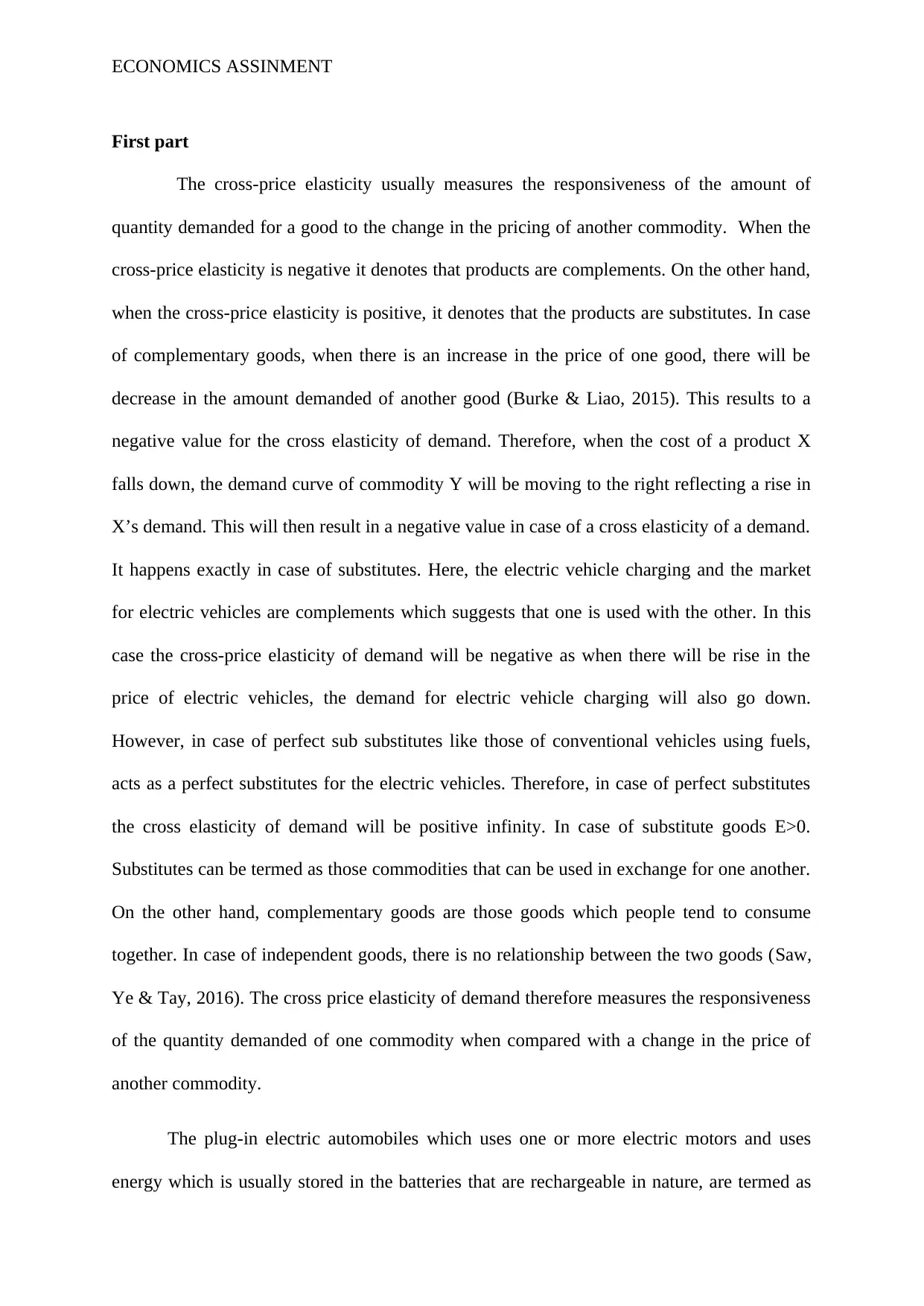
ECONOMICS ASSINMENT
First part
The cross-price elasticity usually measures the responsiveness of the amount of
quantity demanded for a good to the change in the pricing of another commodity. When the
cross-price elasticity is negative it denotes that products are complements. On the other hand,
when the cross-price elasticity is positive, it denotes that the products are substitutes. In case
of complementary goods, when there is an increase in the price of one good, there will be
decrease in the amount demanded of another good (Burke & Liao, 2015). This results to a
negative value for the cross elasticity of demand. Therefore, when the cost of a product X
falls down, the demand curve of commodity Y will be moving to the right reflecting a rise in
X’s demand. This will then result in a negative value in case of a cross elasticity of a demand.
It happens exactly in case of substitutes. Here, the electric vehicle charging and the market
for electric vehicles are complements which suggests that one is used with the other. In this
case the cross-price elasticity of demand will be negative as when there will be rise in the
price of electric vehicles, the demand for electric vehicle charging will also go down.
However, in case of perfect sub substitutes like those of conventional vehicles using fuels,
acts as a perfect substitutes for the electric vehicles. Therefore, in case of perfect substitutes
the cross elasticity of demand will be positive infinity. In case of substitute goods E>0.
Substitutes can be termed as those commodities that can be used in exchange for one another.
On the other hand, complementary goods are those goods which people tend to consume
together. In case of independent goods, there is no relationship between the two goods (Saw,
Ye & Tay, 2016). The cross price elasticity of demand therefore measures the responsiveness
of the quantity demanded of one commodity when compared with a change in the price of
another commodity.
The plug-in electric automobiles which uses one or more electric motors and uses
energy which is usually stored in the batteries that are rechargeable in nature, are termed as
First part
The cross-price elasticity usually measures the responsiveness of the amount of
quantity demanded for a good to the change in the pricing of another commodity. When the
cross-price elasticity is negative it denotes that products are complements. On the other hand,
when the cross-price elasticity is positive, it denotes that the products are substitutes. In case
of complementary goods, when there is an increase in the price of one good, there will be
decrease in the amount demanded of another good (Burke & Liao, 2015). This results to a
negative value for the cross elasticity of demand. Therefore, when the cost of a product X
falls down, the demand curve of commodity Y will be moving to the right reflecting a rise in
X’s demand. This will then result in a negative value in case of a cross elasticity of a demand.
It happens exactly in case of substitutes. Here, the electric vehicle charging and the market
for electric vehicles are complements which suggests that one is used with the other. In this
case the cross-price elasticity of demand will be negative as when there will be rise in the
price of electric vehicles, the demand for electric vehicle charging will also go down.
However, in case of perfect sub substitutes like those of conventional vehicles using fuels,
acts as a perfect substitutes for the electric vehicles. Therefore, in case of perfect substitutes
the cross elasticity of demand will be positive infinity. In case of substitute goods E>0.
Substitutes can be termed as those commodities that can be used in exchange for one another.
On the other hand, complementary goods are those goods which people tend to consume
together. In case of independent goods, there is no relationship between the two goods (Saw,
Ye & Tay, 2016). The cross price elasticity of demand therefore measures the responsiveness
of the quantity demanded of one commodity when compared with a change in the price of
another commodity.
The plug-in electric automobiles which uses one or more electric motors and uses
energy which is usually stored in the batteries that are rechargeable in nature, are termed as
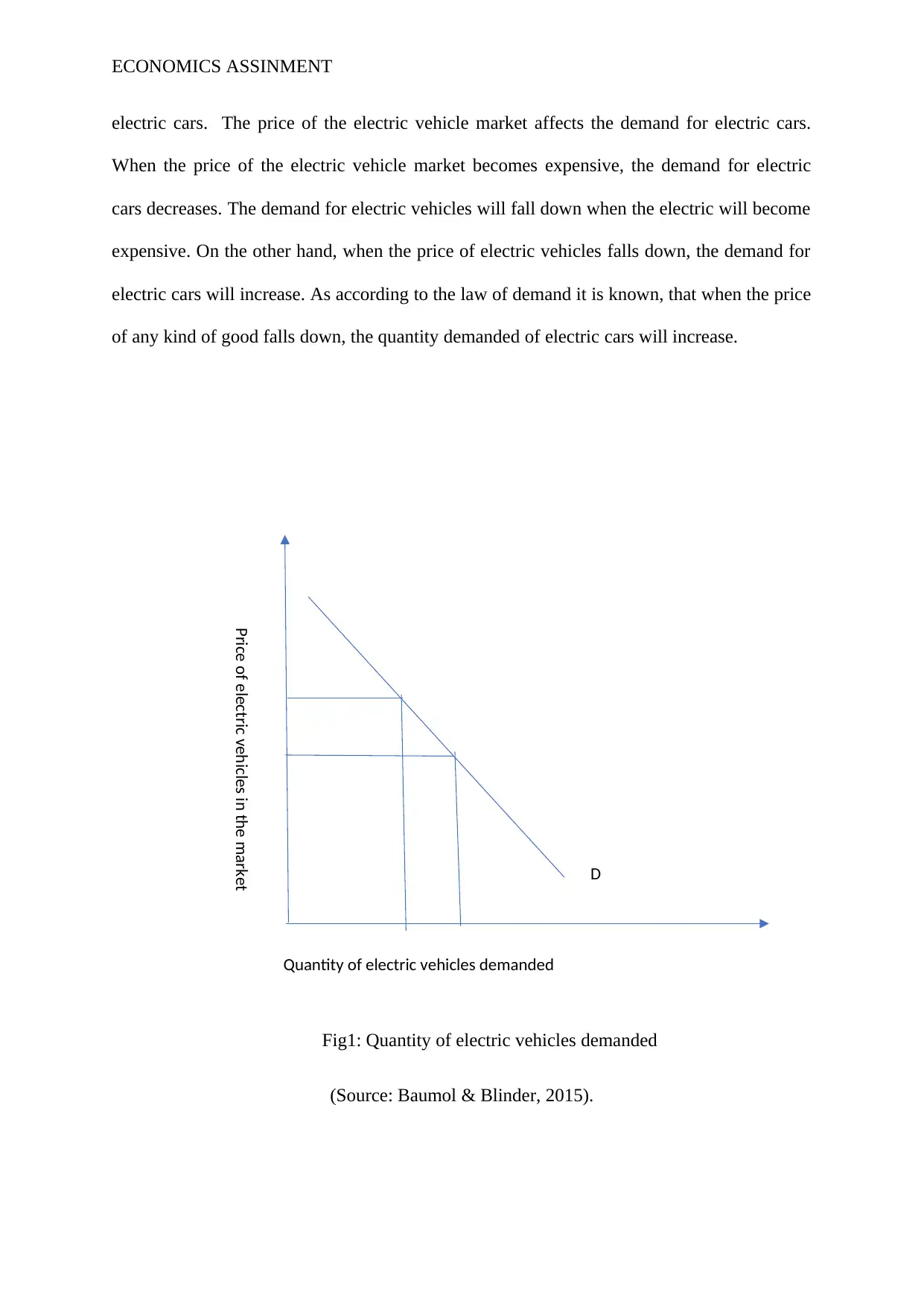
Price of electric vehicles in the market
Quantity of electric vehicles demanded
D
ECONOMICS ASSINMENT
electric cars. The price of the electric vehicle market affects the demand for electric cars.
When the price of the electric vehicle market becomes expensive, the demand for electric
cars decreases. The demand for electric vehicles will fall down when the electric will become
expensive. On the other hand, when the price of electric vehicles falls down, the demand for
electric cars will increase. As according to the law of demand it is known, that when the price
of any kind of good falls down, the quantity demanded of electric cars will increase.
Fig1: Quantity of electric vehicles demanded
(Source: Baumol & Blinder, 2015).
Quantity of electric vehicles demanded
D
ECONOMICS ASSINMENT
electric cars. The price of the electric vehicle market affects the demand for electric cars.
When the price of the electric vehicle market becomes expensive, the demand for electric
cars decreases. The demand for electric vehicles will fall down when the electric will become
expensive. On the other hand, when the price of electric vehicles falls down, the demand for
electric cars will increase. As according to the law of demand it is known, that when the price
of any kind of good falls down, the quantity demanded of electric cars will increase.
Fig1: Quantity of electric vehicles demanded
(Source: Baumol & Blinder, 2015).
⊘ This is a preview!⊘
Do you want full access?
Subscribe today to unlock all pages.

Trusted by 1+ million students worldwide

ECONOMICS ASSINMENT
The market for electric vehicle charging is also related to the market for electric
vehicles. As electric vehicles are mostly charged in the electric vehicle charging station, the
market for charging vehicles is directly related to the demand of electric automobiles. An
electric vehicle charging station is a kind of element in an infrastructure that will provide
electric energy to the vehicles that run on electricity (Huang, Kuo & Chou, 2018). When the
electric cars will become expensive, people will stop buying more cars and therefore, in a
similar way, the charging point will also be not bought. As the charger is an indispensable
part of the vehicle, therefore, its demand will increase with the increase in demand of the
vehicle and will decrease with fall in demand for vehicle.
Fig2: Demand for electric vehicles when the pricing of the vehicle changes.
P1
P2
Q1 Q2
D
Price of electric vehicle charging
Quantity demanded of electric vehicles
The market for electric vehicle charging is also related to the market for electric
vehicles. As electric vehicles are mostly charged in the electric vehicle charging station, the
market for charging vehicles is directly related to the demand of electric automobiles. An
electric vehicle charging station is a kind of element in an infrastructure that will provide
electric energy to the vehicles that run on electricity (Huang, Kuo & Chou, 2018). When the
electric cars will become expensive, people will stop buying more cars and therefore, in a
similar way, the charging point will also be not bought. As the charger is an indispensable
part of the vehicle, therefore, its demand will increase with the increase in demand of the
vehicle and will decrease with fall in demand for vehicle.
Fig2: Demand for electric vehicles when the pricing of the vehicle changes.
P1
P2
Q1 Q2
D
Price of electric vehicle charging
Quantity demanded of electric vehicles
Paraphrase This Document
Need a fresh take? Get an instant paraphrase of this document with our AI Paraphraser
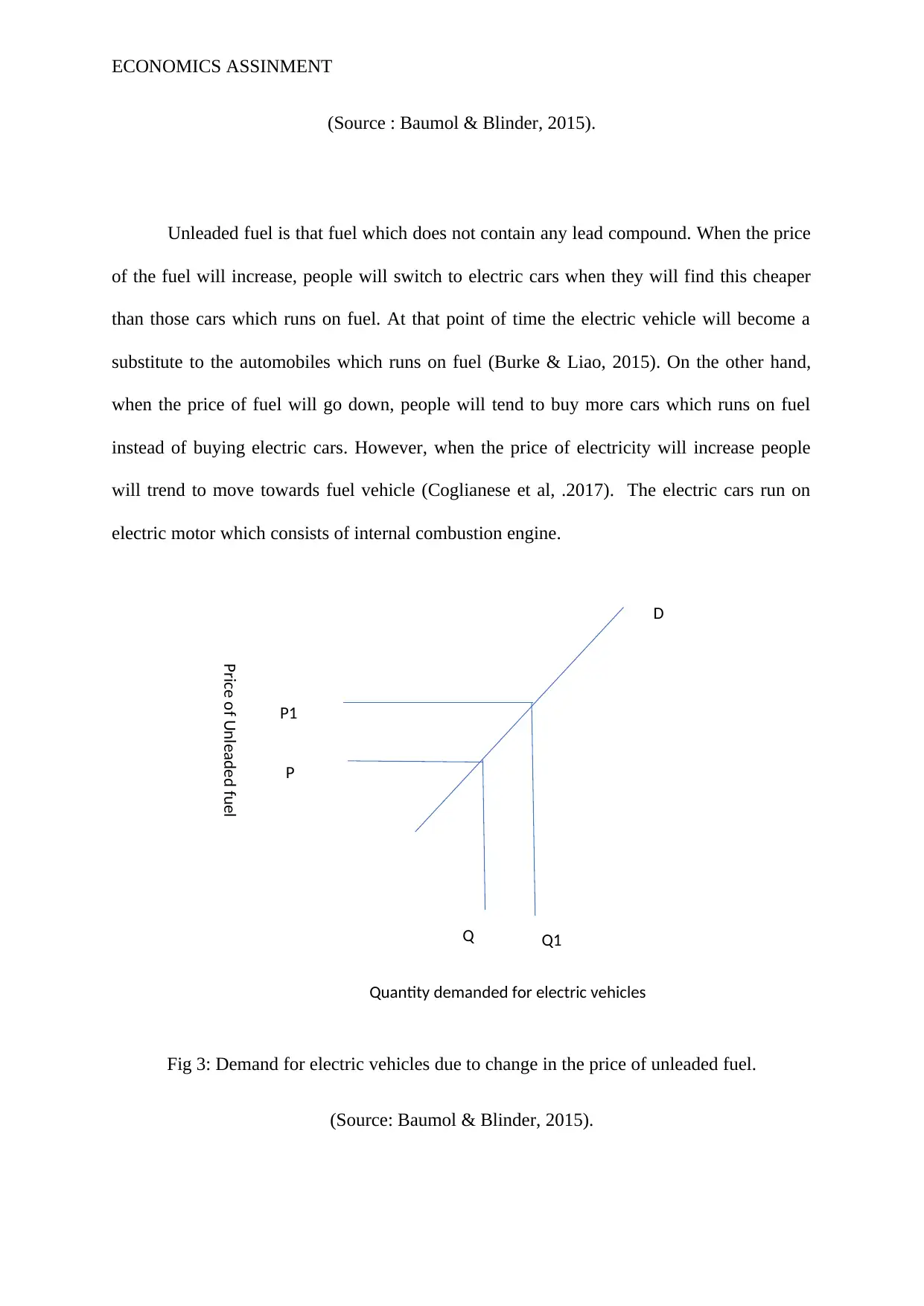
Price of Unleaded fuel
Quantity demanded for electric vehicles
Q Q1
P
P1
D
ECONOMICS ASSINMENT
(Source : Baumol & Blinder, 2015).
Unleaded fuel is that fuel which does not contain any lead compound. When the price
of the fuel will increase, people will switch to electric cars when they will find this cheaper
than those cars which runs on fuel. At that point of time the electric vehicle will become a
substitute to the automobiles which runs on fuel (Burke & Liao, 2015). On the other hand,
when the price of fuel will go down, people will tend to buy more cars which runs on fuel
instead of buying electric cars. However, when the price of electricity will increase people
will trend to move towards fuel vehicle (Coglianese et al, .2017). The electric cars run on
electric motor which consists of internal combustion engine.
Fig 3: Demand for electric vehicles due to change in the price of unleaded fuel.
(Source: Baumol & Blinder, 2015).
Quantity demanded for electric vehicles
Q Q1
P
P1
D
ECONOMICS ASSINMENT
(Source : Baumol & Blinder, 2015).
Unleaded fuel is that fuel which does not contain any lead compound. When the price
of the fuel will increase, people will switch to electric cars when they will find this cheaper
than those cars which runs on fuel. At that point of time the electric vehicle will become a
substitute to the automobiles which runs on fuel (Burke & Liao, 2015). On the other hand,
when the price of fuel will go down, people will tend to buy more cars which runs on fuel
instead of buying electric cars. However, when the price of electricity will increase people
will trend to move towards fuel vehicle (Coglianese et al, .2017). The electric cars run on
electric motor which consists of internal combustion engine.
Fig 3: Demand for electric vehicles due to change in the price of unleaded fuel.
(Source: Baumol & Blinder, 2015).
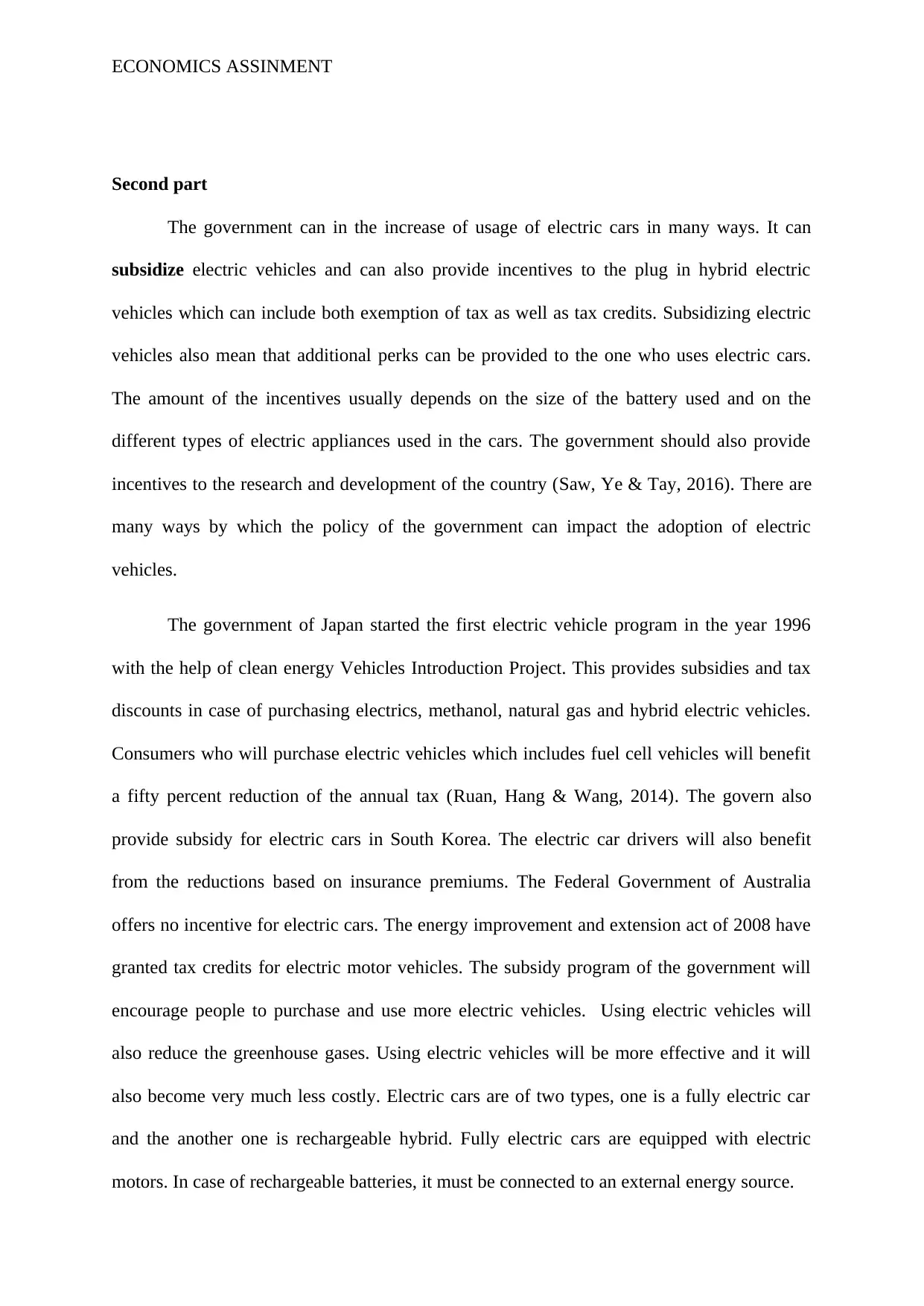
ECONOMICS ASSINMENT
Second part
The government can in the increase of usage of electric cars in many ways. It can
subsidize electric vehicles and can also provide incentives to the plug in hybrid electric
vehicles which can include both exemption of tax as well as tax credits. Subsidizing electric
vehicles also mean that additional perks can be provided to the one who uses electric cars.
The amount of the incentives usually depends on the size of the battery used and on the
different types of electric appliances used in the cars. The government should also provide
incentives to the research and development of the country (Saw, Ye & Tay, 2016). There are
many ways by which the policy of the government can impact the adoption of electric
vehicles.
The government of Japan started the first electric vehicle program in the year 1996
with the help of clean energy Vehicles Introduction Project. This provides subsidies and tax
discounts in case of purchasing electrics, methanol, natural gas and hybrid electric vehicles.
Consumers who will purchase electric vehicles which includes fuel cell vehicles will benefit
a fifty percent reduction of the annual tax (Ruan, Hang & Wang, 2014). The govern also
provide subsidy for electric cars in South Korea. The electric car drivers will also benefit
from the reductions based on insurance premiums. The Federal Government of Australia
offers no incentive for electric cars. The energy improvement and extension act of 2008 have
granted tax credits for electric motor vehicles. The subsidy program of the government will
encourage people to purchase and use more electric vehicles. Using electric vehicles will
also reduce the greenhouse gases. Using electric vehicles will be more effective and it will
also become very much less costly. Electric cars are of two types, one is a fully electric car
and the another one is rechargeable hybrid. Fully electric cars are equipped with electric
motors. In case of rechargeable batteries, it must be connected to an external energy source.
Second part
The government can in the increase of usage of electric cars in many ways. It can
subsidize electric vehicles and can also provide incentives to the plug in hybrid electric
vehicles which can include both exemption of tax as well as tax credits. Subsidizing electric
vehicles also mean that additional perks can be provided to the one who uses electric cars.
The amount of the incentives usually depends on the size of the battery used and on the
different types of electric appliances used in the cars. The government should also provide
incentives to the research and development of the country (Saw, Ye & Tay, 2016). There are
many ways by which the policy of the government can impact the adoption of electric
vehicles.
The government of Japan started the first electric vehicle program in the year 1996
with the help of clean energy Vehicles Introduction Project. This provides subsidies and tax
discounts in case of purchasing electrics, methanol, natural gas and hybrid electric vehicles.
Consumers who will purchase electric vehicles which includes fuel cell vehicles will benefit
a fifty percent reduction of the annual tax (Ruan, Hang & Wang, 2014). The govern also
provide subsidy for electric cars in South Korea. The electric car drivers will also benefit
from the reductions based on insurance premiums. The Federal Government of Australia
offers no incentive for electric cars. The energy improvement and extension act of 2008 have
granted tax credits for electric motor vehicles. The subsidy program of the government will
encourage people to purchase and use more electric vehicles. Using electric vehicles will
also reduce the greenhouse gases. Using electric vehicles will be more effective and it will
also become very much less costly. Electric cars are of two types, one is a fully electric car
and the another one is rechargeable hybrid. Fully electric cars are equipped with electric
motors. In case of rechargeable batteries, it must be connected to an external energy source.
⊘ This is a preview!⊘
Do you want full access?
Subscribe today to unlock all pages.

Trusted by 1+ million students worldwide
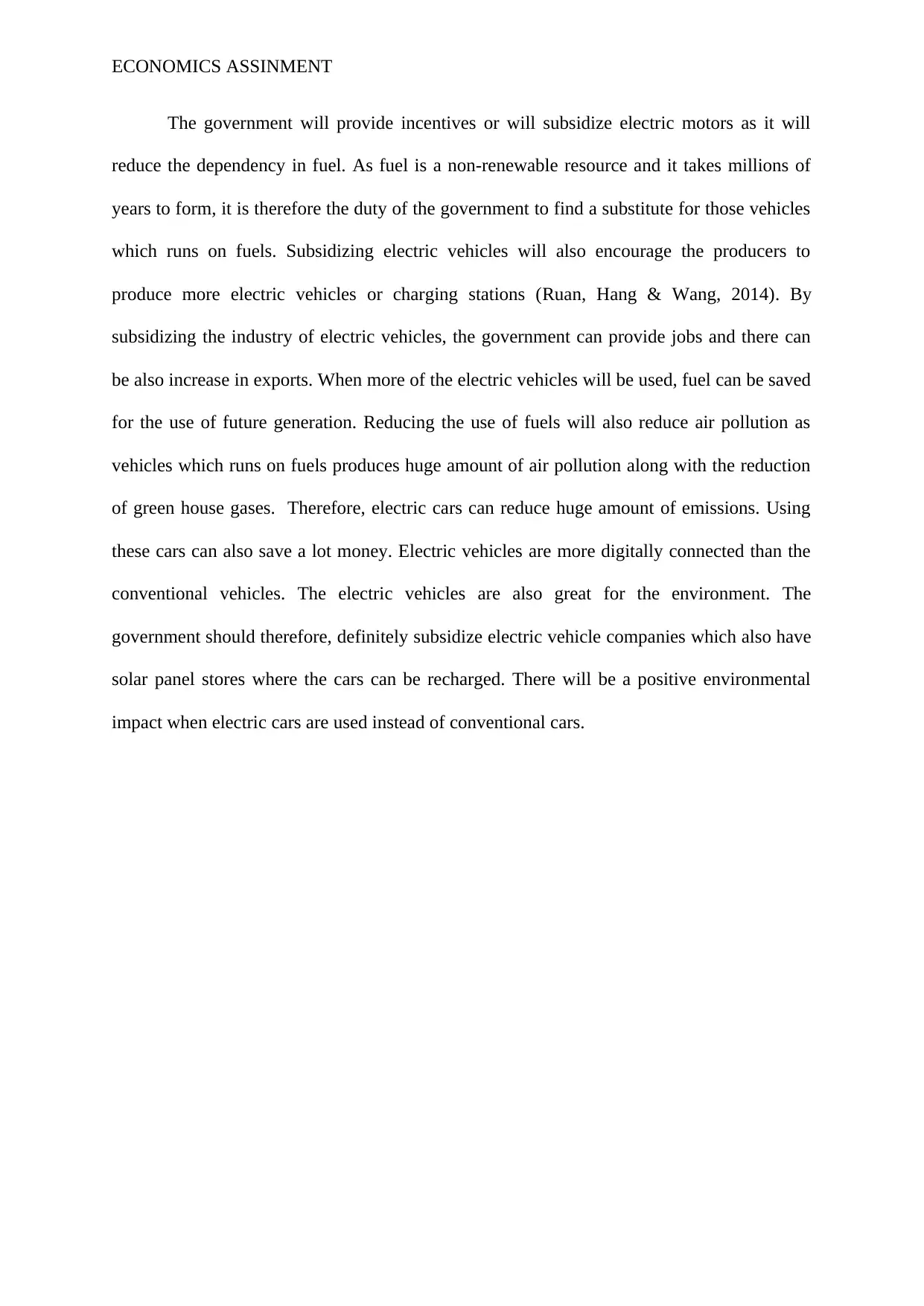
ECONOMICS ASSINMENT
The government will provide incentives or will subsidize electric motors as it will
reduce the dependency in fuel. As fuel is a non-renewable resource and it takes millions of
years to form, it is therefore the duty of the government to find a substitute for those vehicles
which runs on fuels. Subsidizing electric vehicles will also encourage the producers to
produce more electric vehicles or charging stations (Ruan, Hang & Wang, 2014). By
subsidizing the industry of electric vehicles, the government can provide jobs and there can
be also increase in exports. When more of the electric vehicles will be used, fuel can be saved
for the use of future generation. Reducing the use of fuels will also reduce air pollution as
vehicles which runs on fuels produces huge amount of air pollution along with the reduction
of green house gases. Therefore, electric cars can reduce huge amount of emissions. Using
these cars can also save a lot money. Electric vehicles are more digitally connected than the
conventional vehicles. The electric vehicles are also great for the environment. The
government should therefore, definitely subsidize electric vehicle companies which also have
solar panel stores where the cars can be recharged. There will be a positive environmental
impact when electric cars are used instead of conventional cars.
The government will provide incentives or will subsidize electric motors as it will
reduce the dependency in fuel. As fuel is a non-renewable resource and it takes millions of
years to form, it is therefore the duty of the government to find a substitute for those vehicles
which runs on fuels. Subsidizing electric vehicles will also encourage the producers to
produce more electric vehicles or charging stations (Ruan, Hang & Wang, 2014). By
subsidizing the industry of electric vehicles, the government can provide jobs and there can
be also increase in exports. When more of the electric vehicles will be used, fuel can be saved
for the use of future generation. Reducing the use of fuels will also reduce air pollution as
vehicles which runs on fuels produces huge amount of air pollution along with the reduction
of green house gases. Therefore, electric cars can reduce huge amount of emissions. Using
these cars can also save a lot money. Electric vehicles are more digitally connected than the
conventional vehicles. The electric vehicles are also great for the environment. The
government should therefore, definitely subsidize electric vehicle companies which also have
solar panel stores where the cars can be recharged. There will be a positive environmental
impact when electric cars are used instead of conventional cars.
Paraphrase This Document
Need a fresh take? Get an instant paraphrase of this document with our AI Paraphraser

ECONOMICS ASSINMENT
Reference list
Baumol, W. J., & Blinder, A. S. (2015). Microeconomics: Principles and policy. Nelson
Education.
Burke, P. J., & Liao, H. (2015). Is the price elasticity of demand for coal in China
increasing?. China Economic Review, 36, 309-322.
Coglianese, J., Davis, L. W., Kilian, L., & Stock, J. H. (2017). Anticipation, tax avoidance,
and the price elasticity of gasoline demand. Journal of Applied Econometrics, 32(1),
1-15.
Guerrero-López, C. M., Unar-Munguía, M., & Colchero, M. A. (2017). Price elasticity of the
demand for soft drinks, other sugar-sweetened beverages and energy dense food in
Chile. BMC public health, 17(1), 180.
Holland, S. P., Mansur, E. T., Muller, N. Z., & Yates, A. J. (2016). Are there environmental
benefits from driving electric vehicles? The importance of local factors. American
Economic Review, 106(12), 3700-3729.
Huang, S. K., Kuo, L., & Chou, K. L. (2018). The impacts of government policies on green
utilization diffusion and social benefits–A case study of electric motorcycles in
Taiwan. Energy Policy, 119, 473-486.
Mi, C., & Masrur, M. A. (2017). Hybrid electric vehicles: principles and applications with
practical perspectives. John Wiley & Sons.
Miller, M., & Alberini, A. (2016). Sensitivity of price elasticity of demand to aggregation,
unobserved heterogeneity, price trends, and price endogeneity: Evidence from US
Data. Energy Policy, 97, 235-249.
Reference list
Baumol, W. J., & Blinder, A. S. (2015). Microeconomics: Principles and policy. Nelson
Education.
Burke, P. J., & Liao, H. (2015). Is the price elasticity of demand for coal in China
increasing?. China Economic Review, 36, 309-322.
Coglianese, J., Davis, L. W., Kilian, L., & Stock, J. H. (2017). Anticipation, tax avoidance,
and the price elasticity of gasoline demand. Journal of Applied Econometrics, 32(1),
1-15.
Guerrero-López, C. M., Unar-Munguía, M., & Colchero, M. A. (2017). Price elasticity of the
demand for soft drinks, other sugar-sweetened beverages and energy dense food in
Chile. BMC public health, 17(1), 180.
Holland, S. P., Mansur, E. T., Muller, N. Z., & Yates, A. J. (2016). Are there environmental
benefits from driving electric vehicles? The importance of local factors. American
Economic Review, 106(12), 3700-3729.
Huang, S. K., Kuo, L., & Chou, K. L. (2018). The impacts of government policies on green
utilization diffusion and social benefits–A case study of electric motorcycles in
Taiwan. Energy Policy, 119, 473-486.
Mi, C., & Masrur, M. A. (2017). Hybrid electric vehicles: principles and applications with
practical perspectives. John Wiley & Sons.
Miller, M., & Alberini, A. (2016). Sensitivity of price elasticity of demand to aggregation,
unobserved heterogeneity, price trends, and price endogeneity: Evidence from US
Data. Energy Policy, 97, 235-249.

ECONOMICS ASSINMENT
Ruan, Y., Hang, C. C., & Wang, Y. M. (2014). Government׳ s role in disruptive innovation
and industry emergence: The case of the electric bike in China. Technovation, 34(12),
785-796.
Saw, L. H., Ye, Y., & Tay, A. A. (2016). Integration issues of lithium-ion battery into electric
vehicles battery pack. Journal of Cleaner Production, 113, 1032-1045.
Wu, X., Freese, D., Cabrera, A., & Kitch, W. A. (2015). Electric vehicles’ energy
consumption measurement and estimation. Transportation Research Part D:
Transport and Environment, 34, 52-67.
Ruan, Y., Hang, C. C., & Wang, Y. M. (2014). Government׳ s role in disruptive innovation
and industry emergence: The case of the electric bike in China. Technovation, 34(12),
785-796.
Saw, L. H., Ye, Y., & Tay, A. A. (2016). Integration issues of lithium-ion battery into electric
vehicles battery pack. Journal of Cleaner Production, 113, 1032-1045.
Wu, X., Freese, D., Cabrera, A., & Kitch, W. A. (2015). Electric vehicles’ energy
consumption measurement and estimation. Transportation Research Part D:
Transport and Environment, 34, 52-67.
⊘ This is a preview!⊘
Do you want full access?
Subscribe today to unlock all pages.

Trusted by 1+ million students worldwide
1 out of 9
Related Documents
Your All-in-One AI-Powered Toolkit for Academic Success.
+13062052269
info@desklib.com
Available 24*7 on WhatsApp / Email
![[object Object]](/_next/static/media/star-bottom.7253800d.svg)
Unlock your academic potential
Copyright © 2020–2025 A2Z Services. All Rights Reserved. Developed and managed by ZUCOL.





